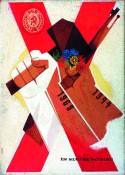From Timisoara to Ceaușescu: a research project shaped by UNITAFeedback from a UPPA student
_max0x640.png?objectId=defaultWebContent://568f4c17-064f-44fe-af12-cb71c98865a8)
Thanks to UNITA mobility opportunities, Émeric Charpentier, a Master’s student in Art History at UPPA, found his research path. His thesis focuses on propaganda posters from Ceaușescu’s dictatorship in Romania.
A BIP that sparked a calling
It all started with an unexpected opportunity. While in his third year of Art History studies at UPPA, Émeric heard about a Blended Intensive Program (BIP) held at the University of Timisoara, Romania. Encouraged by a friend, he signed up. This European program, titled Intercomprehension for Language for Specific Purposes (LSP), brings together students from several partner universities to explore intercomprehension—an approach that facilitates communication among speakers of Romance languages without formal study.
The experience made a strong impression: “Great atmosphere, meaningful encounters, inspiring teachers, and a beautiful city to discover.” But most importantly, it planted a seed: why not dedicate his Master’s thesis to Romania?
A research path shaped by Romania
Back at UPPA for his Master 1, Émeric refined his academic focus. Fascinated by the Balkans since the beginning of his studies, he chose to investigate a corpus of propaganda posters from the Ceaușescu regime (1965–1989). His topic remains largely unexplored: most documents are poorly dated, unsigned, and still under-researched.
Émeric’s approach bridges multiple fields: political history, visual aesthetics, and symbolic analysis. He studies how poster design evolved, especially the rise of the cult of personality in the 1970s, echoing visual codes seen in the USSR decades earlier. He also draws connections to other visual productions, such as cinema posters, to assess recurring themes and styles.
Intercomprehension: both a tool and a spark
Determined, Émeric began learning Romanian early—long before considering long-term mobility. Through UNITA, he benefited from a virtual mobility program focused on learning Romanian, which helped him reach an A2/B1 level while staying in France.
Although he didn’t feel confident enough yet for an Erasmus exchange, he returned to Timisoara in March 2025 to attend the same BIP again. This second trip served a dual purpose: deepen his knowledge of intercomprehension and reconnect with local professors, but also begin archival research on-site. He is now in touch with Romanian researchers and preparing a new trip to collect additional materials for his thesis.
A project rooted in experience
Émeric’s enthusiasm is contagious. His thesis topic—original, ambitious, and deeply personal—was shaped organically thanks to UNITA mobility opportunities. A PhD might be on the horizon. “I’m truly passionate about this topic, and there’s still so much to uncover,” he shares.
With no personal ties to Romania, Émeric is the perfect example of how European mobility can profoundly shape an academic journey. His story highlights the power of curiosity, interdisciplinarity, and the value of international collaboration.

